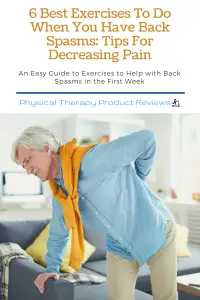 Do you have back spasms that just won’t seem to go away? You are not alone. Back spasms can be a persistent and stubborn problem, but there are many things you can do to minimize the time they last or prevent them from happening at all.
Do you have back spasms that just won’t seem to go away? You are not alone. Back spasms can be a persistent and stubborn problem, but there are many things you can do to minimize the time they last or prevent them from happening at all.
If you are struggling with back spasms then you’ll do just about anything to get them over with and take away the pain. We are here to help!
In this article, we will cover 6 exercises that will decrease back pain and provide tips for preventing muscle spasms in the future!
What Causes Back Spasms?
If you are experiencing back spasms, it is important to understand what causes them and how they work.
Back spasms occur when a muscle group gets caught in an overactive state. Back spasms can be triggered by an injury to the spine such as disc herniation, a muscle strain, or an injury to the facet joints in the spine. When one of these structures becomes injured the body may go into spasms to try and protect that area.
In some cases, back spasms may even happen for no apparent reason. You may just bend over to pick up a toy or to reach into a cabinet and that may be enough to start a back spasm.
6 Exercises to Do to Help With Back Spasms
Listed below are 6 easy stretching and strengthening exercises to help decrease active muscle spasms. Try and perform these multiple times a day until the muscle spasms stop.
Child's Pose Stretch
This is a great stretch to do when you are back spasms. Start on your hands and knees and slowly drop your hips down to your feet rounding your back.
Make sure that you keep your arms out in front of you. Hold for at least 30 seconds each time.
Video Link:
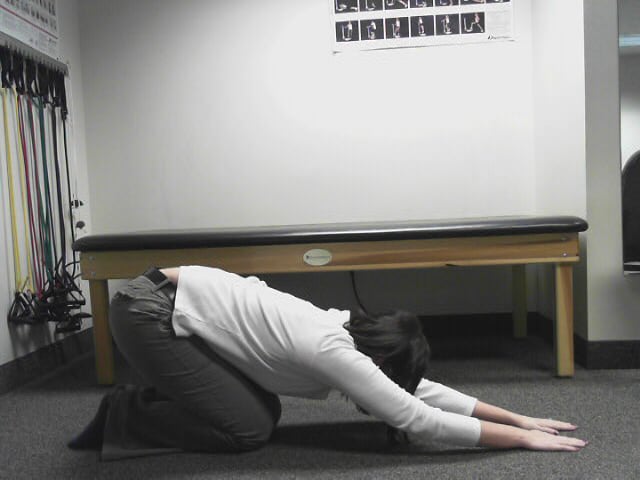
Prone Press Up
Start by lying on your stomach with your hands underneath your shoulders on the ground. Push through the ground and lift up your upper body off of the mat while keeping the front of your hips flat on the floor.
Extend your back bending up toward the ceiling. Lower back into starting position then repeat this for 12-15 repetitions or until you feel better.
Video Link:
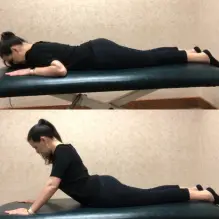
Lumbar Twist Stretch
Lie on the ground with your back straight. Cross one leg over the other and take a hold of that leg with the other hand.
Pull the leg across your body so that your back twists to one side. Hold for at least 30 seconds each time then switch sides.
Video Link:
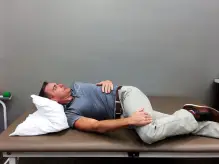
Cat-Cow Stretch
Get on your hands and knees with your back straight. Take a deep breath in, then exhale as you curve the back upwards into an inverted “U” shape.
Inhale deeply again, this time arching back up to round the spine like a cow’s back before returning to start position.
Repeat this back and forth for 12-15 repetitions or until you feel better.
Video Link:
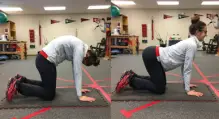
Hip Bridges
Lie on back with knees bent and feet flat. Slowly lift your hips off the ground while keeping your neck and head flat to the mat or floor.
Lift your hips as high as you can really focusing on using your glutes and back muscles.
Hold for a few seconds before lowering back down to the start position then repeat this 12-15 repetitions or until you feel better.
Video Link:
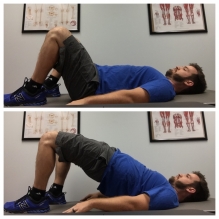
Swiss Ball Traction
Position yourself on your stomach laying on top of a swiss ball or exercise ball. Slowly exhale and roll back and forth forward and backward.
This motion opens up the spine and stretches the muscles. This is a personal favorite and a great way to loosen up the muscles.
Video Link:
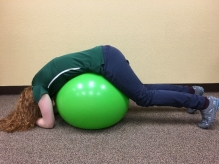
Other Tips to Help with Back Spasms
Besides performing stretches and strengthening exercises to help with low back pain there are a few other things that you can do to help speed up recovery.
Use a Hot Pack
For back spasms that are caused by muscle strain, you can apply a hot pack to the painful muscles. This will help loosen them up and make it easier for blood flow to return back into the area.
Stay Active With Walking or Riding a Back Bike
If back spasms are the result of a recent injury then it is important to stay as active as possible. This will help with healing and decrease back pain in the long term.

Walking and riding a bike helps the joints in the back open up and be more mobile. This in return helps the muscle in the back relax quicker.
Walking and riding a bike are some of the best things that you can do with back spasms.
Sleep with a Pillow Between Your Knees
Sleeping can be uncomfortable with back spasms but one position that may be comfortable is sleeping on your side with a pillow between the knees. This takes the pressure off your spine to help you sleep.
Use a TENS Unit
TENS units come in many shapes and sizes. They work by sending electric currents to the back muscles through wires that are attached to adhesive pads. This sends signals back into those spasming muscle groups in an effort to help them relax.
These devices can be used for back spasms or any type of pain you’re experiencing in your back area.
Tips for Preventing Spasms in the Future
There are a few things that you can do to help prevent back spasms from happening again.
Work on Stabilizing Your Core Muscles and Strengthening Them with Exercises
You want your back muscles to be strong to provide optimal stability to your spine. The stronger your back and core muscle are the less at risk it is for injury or for spasms to come back again.
Stay Active to Help with Healing
The back muscles are not the only thing that heals after an injury. The more active you are the stronger and healthier the hips, legs, and other joints are that connect and surround the area that is prone to muscle spasms.
Stretch Regularly
Stretching helps keep back spasms from happening again by lengthening your muscle fibers and making them more elastic. Stretching is associated with overall back and muscle health.
FAQ About Back Spasms
We prefer using heat to help stop back spasms. The heat will reduce muscle tension and bring blood flow to the area which can speed up healing.
Absolutely! A hot tub is one of the best things that you can for back spasms.
The heat will help relax the muscles and you can use the jets to help massage the area that hurts.
Just be cautious and don't spend more than 30-40m minutes without taking a break.
Not right away! We recommend being able to walk 30 minutes without an increase in pain or spasms before you try to run.
This may take a few weeks before you are able to run without pain.
Swimming is an excellent activity to do to help with back spasms.
The bouncy of the water can help decompress the spine and relax the muscles.
It may take a few weeks before you are able to swim laps like normal,
Yes you can drive with back spasms as long as you are not currently taking narcotic pain medication.
Try rolling up a towel or using a pillow behind your back to provide support and reduce to intensity of back spasms.
Conclusion
The back muscles are an important part of the body that is prone to muscle spasms due to injury or strain. These can be prevented with some helpful exercises and tips for decreasing back pain such as using a hot pack, sleeping on your side with a pillow between knees, working on stabilizing core muscles and keeping them strong through exercise routines, staying active, and stretching.
Other Great Rehab Related Articles
How to Stay Active After Cervical Fractures: Expert Tips and Advice
Dealing with Painful Stairs After Ankle Replacement Surgery
Walking After a Total Ankle Replacement: Tips for a Successful Recovery
Exercises While Non-Weight Bearing After Ankle Replacement: Elevation, AROM, Leg Raises, and More
Ankle Pain with Stairs: Causes and Home Treatment Options
5 Common Mistakes You’re Making After an Ankle Sprain
Disclaimer: The information provided in this post is for educational purposes only. This is not a substitute for a medical appointment. Please refer to your physician before starting any exercise program.








